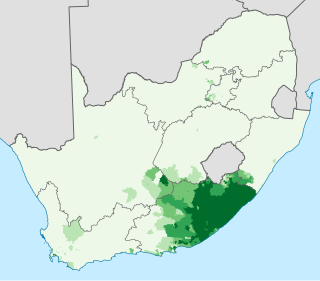Consonants
Juǀʼhoan has an unusually large number of consonants, even for a !Kung language. The following occur at the beginnings of roots. For brevity, only the alveolar clicks are listed with the other consonants; the complete set of clicks is found below.
Tenuis and modally voiced consonants (blue) may occur with any vowel quality. However, other consonants (grey, transcribed with a superscript diacritic to their right) do not occur in the same root as murmured, glottalized, or epiglottalized vowels.
The voiced aspirated and ejective consonants, both pulmonic and clicks, contain a voiceless interval, which Miller (2003) attributes to a larger glottal opening than is found in Hindustani breathy-voiced consonants. Phonetically, however, they are voice contours, starting out voiced but becoming voiceless for the aspiration or ejection. [3]
The phonemic status of [ʔ], [dz] and [dʒ] is uncertain. [ʔ] may be epenthetic before vowel-initial words; alternatively, it may be that no word may begin with a vowel. /mʱ/ occurs only in a single morpheme, the plural diminutive enclitic /mʱi/. /f/ and /l/ (not shown) only occur in loan words, and some accounts posit a /j/ and /w/. Labials (/p, pʰ, b, bʱ, m/) are very rare initially, though common between vowels. Velar stops (oral and nasal) are rare initially and very rare medially.
The consonants listed as epiglottalized, following Miller-Ockhuizen (2003), have uvular frication and glottalization; they are similar to consonants in Nǀu described as uvular ejective by Miller et al. (2009).
Only a small set of consonants occur between vowels within roots. These are:
| Labial | Alveolar | Velar | Uvular | Glottal |
| β̞ | ɾ | ɣ | | |
| m | n | ŋ | | |
| | k, ŋk | qʜ | |
| | | χ | ɦ |
Medial [β̞, ɾ, m, n] (green) are very common; [ɣ, ŋ] are rare, and the other medial consonants occur in only a very few roots, many of them loans. [β̞, ɾ, ɣ] are generally analyzed as allophones of /b, d, ɡ/. However, [ɾ] especially may correspond to multiple root-initial consonants.
Juǀʼhoan has 48 click consonants. There are four click "types": dental, lateral, alveolar, and palatal, each of which found in twelve series or "accompaniments" (combinations of manner, phonation, and contour). These are perfectly normal consonants in Juǀʼhoan, and indeed are preferred over non-clicks in word-initial position.
| 'noisy' clicks | 'sharp' clicks | series |
|---|
| dental | lateral | alveolar | palatal |
| ǀ | ǁ | ǃ | ǂ | Tenuis |
| ᶢǀ | ᶢǁ | ᶢǃ | ᶢǂ | Voiced |
| ᵑǀ | ᵑǁ | ᵑǃ | ᵑǂ | Nasal |
| ǀʰ | ǁʰ | ǃʰ | ǂʰ | Aspirated |
| ᶢǀʱ | ᶢǁʱ | ᶢǃʱ | ᶢǂʱ | Murmured? (or pre-voiced aspirated) |
| ᵑ̊ǀʰ | ᵑ̊ǁʰ | ᵑ̊ǃʰ | ᵑ̊ǂʰ | Aspirated nasal |
| ᵑǀʱ | ᵑǁʱ | ᵑǃʱ | ᵑǂʱ | Murmured nasal |
| ǀˀ | ǁˀ | ǃˀ | ǂˀ | Glottalized nasal |
| ǀᵡ | ǁᵡ | ǃᵡ | ǂᵡ | Linguo-pulmonic contour |
| ᶢǀʶ | ᶢǁʶ | ᶢǃʶ | ᶢǂʶ | Voiced linguo-pulmonic |
| ǀʜ | ǁʜ | ǃʜ | ǂʜ | Epiglottalized (heterorganic contour) |
| ᶢǀʢ | ᶢǁʢ | ᶢǃʢ | ᶢǂʢ | Voiced epiglottalized |
As above, tenuis and modally voiced consonants (blue) may occur with any vowel quality. However, other consonants (grey, transcribed with a superscript diacritic to their right) do not occur in the same root as murmured, glottalized, or epiglottalized vowels.
Glottalized clicks occur almost exclusively before nasal vowels. This may indicate that these clicks are nasalized [ᵑǃˀ], etc., as is the case in most if not all other languages with glottalized clicks. The nasalization would not be audible during the click itself due to the glottalization, which would prevent any nasal airflow, but the velum would be lowered, potentially nasalizing adjacent vowels.
The 'uvularized' clicks are actually linguo-pulmonic contours, [ǃ͡qχ] and [ᶢǃ͡ɢʁ], etc. The 'epiglottalized' clicks are heterorganic affricates, and equivalent to linguo-glottalic consonants transcribed [ǃ͡kxʼ] and [ᶢǃ͡kxʼ], etc., in other languages (Miller 2011).
In phonetics, contour describes speech sounds which behave as single segments, but which make an internal transition from one quality, place, or manner to another. These sounds may be tones, vowels, or consonants.
See Ekoka !Kung for a related variety with a somewhat larger click inventory.
Ekoka !Kung or Western !Xuun is a variety of the !Kung dialect cluster, spoken originally in the area of the central Namibian–Angolan border, west of the Okavango River, but since the Angolan Civil War also in South Africa.





